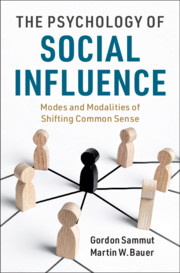Book contents
- The Psychology of Social Influence
- The Psychology of Social Influence
- Copyright page
- Dedication
- Contents
- Figures
- Tables
- Boxes
- Foreword 1
- Foreword 2
- Acknowledgements
- Chapter 1 Modalities of Social Influence
- Part I Recurrent Sources of Populism
- Part II Experimental Paradigms
- Chapter 4 Norming and Framing
- Chapter 5 Conforming and Converting
- Chapter 6 Obeying
- Chapter 7 Persuading and Convincing
- Part III Necessary Extensions
- Part IV Theoretical Integration
- References
- Index
Chapter 7 - Persuading and Convincing
from Part II - Experimental Paradigms
Published online by Cambridge University Press: 19 December 2020
- The Psychology of Social Influence
- The Psychology of Social Influence
- Copyright page
- Dedication
- Contents
- Figures
- Tables
- Boxes
- Foreword 1
- Foreword 2
- Acknowledgements
- Chapter 1 Modalities of Social Influence
- Part I Recurrent Sources of Populism
- Part II Experimental Paradigms
- Chapter 4 Norming and Framing
- Chapter 5 Conforming and Converting
- Chapter 6 Obeying
- Chapter 7 Persuading and Convincing
- Part III Necessary Extensions
- Part IV Theoretical Integration
- References
- Index
Summary
Chapter 7 deals with the most pressing and most prominent social influence in our time, persuasion. The modality of persuasion is oft considered as the epitome of social influence processes with a long past of rhetoric analysis, and a short history of experimental demonstration of effects arising from speaker, message or audience characteristics. The chapter starts by reviewing the moderator variables of persuasion initiated by the Yale Programme. This is followed by considering mainstream dual-process theories that investigated fast or slow, hot or cold cognitive processes resulting in successful persuasion. Following this mainstream overture, the chapter reviews studies of forced and non-forced compliance that precipitate conviction by cognitive dissonance. The chapter ends with reviewing lay epistemic theory and the unimodal of persuasion, making the case for argumentation processes that form attitudes and the appraisal of behavioural inclinations beyond the exercise of mere message tactics of a box of tricks. This leads us to consider the necessary insights into the common ground and the moral community of speaker and audience as a precondition of successful persuasion.
Keywords
- Type
- Chapter
- Information
- The Psychology of Social InfluenceModes and Modalities of Shifting Common Sense, pp. 137 - 160Publisher: Cambridge University PressPrint publication year: 2021



